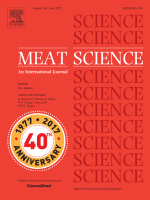
No âmbito do projeto LegForBov foi publicado um artigo na revista Meat Science que aborda os resultados de um ensaio realizado no INIAV-Fonte Boa em que se comparar os resultados produtivos de 2 grupos de bovinos em fase de acabamento em que uma dieta baseada em forragens e com baixa incorporação de cereais foi comparada com uma dieta convencional de concentrado comercial
Volume 198, April 2023, 109098
Forage based diet as an alternative to a high concentrate diet for finishing young bulls - Effects on growth performance, greenhouse gas emissions and meat quality
José Santos-Silva a b c, Susana P. Alves b c d, Alexandra Francisco a b c, Ana Paula Portugal a, Maria Teresa Dentinho a b c, João Almeida a b c, José Leandro Regedor da Silva a, Letícia Fialho b c e, Liliana Cachucho b c e, Eliana Jerónimo e f, Ana Barradas g, António Rodrigues h, Nuno Rodrigues i, Ricardo F.M. Teixeira i j, Tiago Domingos i j, Rui J.B. Bessa b c d
a Instituto Nacional de Investigação Agrária e Veterinária (INIAV), Fonte Boa, 2005-424 Vale de Santarém, Portugal
b CIISA – Centre for Interdisciplinary Research in Animal Health, Faculty of Veterinary Medicine, University of Lisbon, Avenida da Universidade Técnica, 1300-477 Lisboa, Portugal
c Associate Laboratory for Animal and Veterinary Sciences (AL4AnimalS), Avenida da Universidade Técnica, 1300-477 Lisboa, Portugal
d Faculdade de Medicina Veterinária, Universidade de Lisboa, Avenida da Universidade Técnica, 1300-477 Lisboa, Portugal
e Centro de Biotecnologia Agrícola e Agro-Alimentar do Alentejo (CEBAL)/Instituto Politécnico de Beja (IPBeja), 7801-908 Beja, Portugal
f MED – Mediterranean Institute for Agriculture, Environment and Development & CHANGE Instituto para as Alterações Globais e Sustentabilidade, CEBAL, Apartado 6158, 7801-908 Beja, Portugal
g Fertiprado S.A., Herdade dos Esquerdos, Vaiamonte, 7450-250 Monforte, Portugal
h Elipec, Avenida de Badajoz, 3 7350-097 Elvas, Portugal
i Terraprima, Serviços Ambientais, Lda, Quinta da França, 6200-710, Covilhã, Portugal
j MARETEC − Marine, Environment and Technology Centre, LARSyS, Instituto Superior Técnico, Universidade de Lisboa, Av. Rovisco Pais, 1, 1049-001 Lisbon, Portugal
https://doi.org/10.1016/j.meatsci.2023.109098
Abstract
Two groups of 8 individually housed young crossbred-bulls, in the finishing period, were used to test the effect of a Total Mixed Ration diet with high forage content (54% DM), low starch content (14% DM), supplemented with sunflower seeds (10% DM) (HFS) on growth performance, carcass and meat quality, fatty acid profile and carbon footprint, with reference to a conventional concentrate-based (90% DM) (Control) diet. The experiment lasted 64 days before slaughter. During the experiment, feed intake was monitored daily and live weight every 14 days. Individual CH4 emissions were assessed at 16-days intervals, using a GreenFeed for Large Animal unit. Feed intake and feed conversion ratio were higher for HFS diet, but average daily weight gain and feeding costs were similar for the two diets. Dressing percentage was reduced with HFS diet. The HFS increased redness, yellowness and Chroma of subcutaneous fat, but did not compromise commercial value of the carcasses. Meat colour, shear force, or sensory parameters were not affected by diet. The HFS diet allowed a healthier FA profile, due to the higher proportions of 18:3n-3, t11–18:1 and c9,t11–18:2 and the lower proportion of t10–18:1. The HFS diet did not reduce the carbon footprint in the finishing period of young bulls, due to increased digestive CH4 emissions. The results of this experiment showed that the HFS diet can be an alternative to the conventional diets used in finishing young-bulls. Although it may result in a slight reduction in animal performance, it has a strong impact on reducing dependence on inputs from outside the farm.


